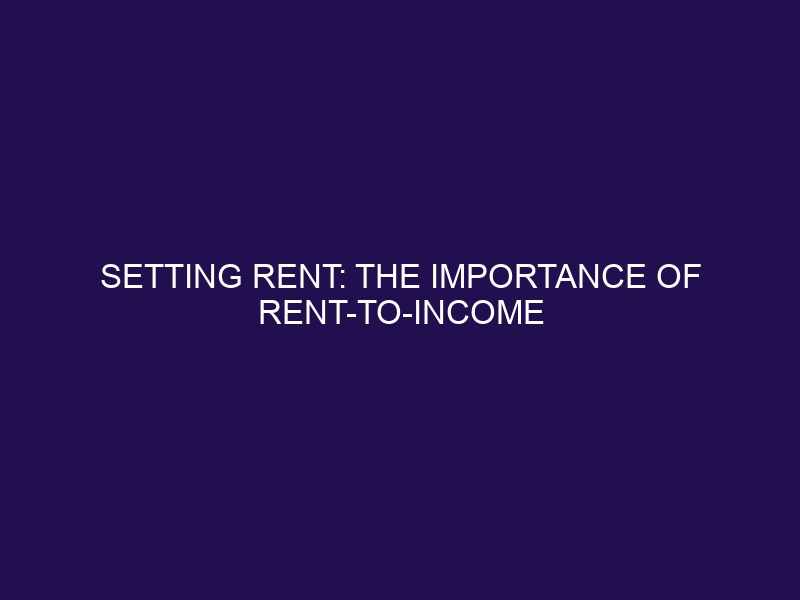Setting Rent: The Importance of Rent-to-Income Ratio
Rent-to-income ratio is a measure of the percentage of a tenant’s income that goes towards paying rent. It is an important factor to consider when setting rent prices for a property. This ratio helps landlords and tenants alike understand the affordability of a rental property and plays a significant role in the renting process.
One of the main reasons why rent-to-income ratio is important is that it helps determine the affordability of a rental property for a tenant. By calculating this ratio, landlords can ensure that their tenants will be able to comfortably pay the rent without facing financial strain. This also helps landlords find reliable tenants who will be able to consistently make timely rent payments.
Calculating the rent-to-income ratio involves comparing a tenant’s income to their rent. It is important to consider both gross and net income, as gross income refers to the total income before taxes and other deductions, while net income is the actual take-home pay.
The recommended rent-to-income ratio varies, but a general rule of thumb is that rent should not exceed 30% of a tenant’s gross income. However, in high-cost areas, this ratio may be higher due to the higher cost of living.
There are several consequences of a high rent-to-income ratio for tenants. Financial strain is a major concern, as it may lead to difficulty in keeping up with other expenses and saving money. This can also limit a tenant’s ability to handle emergencies or unexpected expenses.
Landlords can use the rent-to-income ratio to set rent for their properties. By setting a maximum ratio, landlords can ensure that their tenants will not be facing financial strain due to high rent payments. However, it is also important to consider other factors such as the current rental market, location, and amenities of the property when setting the rent. This helps strike a balance between affordability for the tenants and profitability for the landlord.
What Is Rent-to-Income Ratio?
The rent-to-income ratio, also known as the housing cost ratio, is a measure that calculates the percentage of a person’s income that is used to cover rental expenses. This is a useful tool in determining the affordability of a rental property based on one’s income.
A helpful tip is to aim for a rent-to-income ratio below 30% to ensure manageable housing costs.
Why Is Rent-to-Income Ratio Important?
As a landlord or a potential tenant, understanding the importance of rent-to-income ratio is crucial in the rental process. This ratio serves as a valuable tool in assessing the affordability of rent and avoiding financial strain. In this section, we will discuss the various reasons why rent-to-income ratio is an essential factor to consider when setting rent prices or determining whether a rental property is within a tenant’s budget. Additionally, we will explore how this ratio can also benefit landlords in finding reliable and responsible tenants.
1. Helps Determine Affordability
- Evaluate monthly income and fixed expenses.
- Calculate the rent-to-income ratio by dividing the monthly rent by the monthly income.
- Compare the ratio to recommended thresholds for determining affordability.
2. Helps Avoid Financial Strain
- Track and analyze your monthly income and expenses.
- Create a budget that allocates a reasonable portion of income to rent.
- Consider cost-saving measures to help avoid financial strain, such as cohabiting or finding a more affordable rental.
Real During the Great Depression, many families struggled to avoid financial strain due to high rent-to-income ratios.
3. Helps Landlords Find Reliable Tenants
- Verify Tenant Income: Ensure the applicant’s income is at least three times the rent to ensure they can afford it.
- Assess Stability: Look for consistent income sources such as long-term employment or reliable business income.
- Check Credit and assess financial responsibility.
- Helps Landlords Find Reliable Tenants
How Is Rent-to-Income Ratio Calculated?
When it comes to setting rent, one crucial factor to consider is the rent-to-income ratio. This ratio is a helpful tool for both landlords and tenants in determining an affordable and fair rent price. But how exactly is this ratio calculated? In this section, we will discuss the differences between gross income and net income and how they factor into the rent-to-income ratio. Then, we will delve into the specific steps involved in calculating this important ratio.
1. Gross Income vs Net Income
- Gross Income: The total income before any deductions or taxes are taken out.
- Net Income: The income remaining after deductions such as taxes, insurance, and retirement contributions are subtracted.
2. Calculating Rent-to-Income Ratio
- Determine Gross Monthly Income: Include all income sources before taxes.
- Calculate Total Monthly Rent: Sum of all monthly rental costs.
- Divide Rent by Income: Divide total monthly rent by gross monthly income.
What Is the Recommended Rent-to-Income Ratio?
When it comes to setting rent, there is a crucial factor that landlords and tenants should consider: the rent-to-income ratio. This ratio is a measure of the recommended amount of income that should be spent on rent. In this section, we will discuss the recommended rent-to-income ratio and how it can help both landlords and tenants make informed decisions. We will first explore the general rule of thumb for this ratio, followed by special considerations for high-cost areas where rent may be significantly higher.
1. General Rule of Thumb
- Evaluate the general rule of thumb for the rent-to-income ratio, which is typically around 30% of monthly income.
- Calculate the ratio by dividing the monthly rent by the gross monthly income.
- Take into account individual financial circumstances and regional cost variations when determining this ratio.
2. Considerations for High-Cost Areas
- Research the median incomes and rental prices in high-cost areas.
- Compare the rent-to-income ratios for various locations.
- Consider government housing assistance programs for these expensive areas.
- Adjust tenant requirements based on the specific living costs in the area.
What Are the Consequences of a High Rent-to-Income Ratio?
One of the key factors in determining the affordability of housing is the rent-to-income ratio. This ratio measures the percentage of a person’s income that goes towards rent each month. A high rent-to-income ratio can have significant consequences for individuals and families, impacting their financial stability and ability to save money. In this section, we’ll discuss the potential consequences of a high rent-to-income ratio, including financial strain, difficulty saving money, and limited ability to handle emergencies.
1. Financial Strain
- Assess current financial situation to identify any financial strain.
- Review income sources and expenses to understand the potential impact.
- Explore options for reducing financial strain, such as creating a budget or finding additional sources of income.
- Seek financial advice or support if needed to alleviate any strain on your finances.
2. Difficulty Saving Money
- Create a budget to track expenses and savings for those who struggle to save money.
- Automate savings by setting up regular transfers to a separate account for individuals who have a hard time saving.
- Reduce unnecessary expenses to free up more money for savings, especially for those who find it challenging to save.
- Consider alternative income sources or side hustles to boost savings for those who have difficulty saving.
To effectively accumulate savings, it’s crucial to prioritize budgeting, automate savings, and minimize non-essential spending for individuals who struggle to save money.
3. Limited Ability to Handle Emergencies
- Create an emergency fund with enough funds to cover at least three to six months’ worth of living expenses.
- Explore additional sources of income or part-time work to increase financial stability.
- Think about downsizing in order to lower living expenses and establish a more robust financial safety net.
How Can Landlords Use Rent-to-Income Ratio to Set Rent?
As a landlord, it is important to set rent at a reasonable and fair amount for both yourself and your tenants. One method that can help with this decision is using the rent-to-income ratio. In this section, we will discuss how landlords can use this ratio to determine the appropriate rent for their properties. We will also explore the different factors that should be considered in addition to the rent-to-income ratio to ensure a balanced and sustainable rental price.
1. Setting a Maximum Rent-to-Income Ratio
- Analyze the local market to determine the average rent-to-income ratios for comparable properties.
- Evaluate the financial stability and creditworthiness of potential tenants to ensure they can afford the rent.
- Consider setting a maximum rent-to-income ratio of 30% to ensure the property remains affordable for tenants.
When determining a maximum rent-to-income ratio, it is important to find a balance between maximizing rental income and maintaining affordability for potential tenants.
2. Considering Other Factors
- Evaluate the demand and supply dynamics of the local rental market.
- Consider the amenities and condition of the property.
- Assess the tenant’s credit history and track record of rental payments.
- Take into account the potential for rental increases and long-term tenancy.
When determining the rent, it is important to consider these factors in addition to the rent-to-income ratio for a well-rounded approach.
How to Get Started with Begbies Traynor
If you’re wondering how to get started with Begbies Traynor, just take it from my friend who sought their help to restructure his business debts. Thanks to their tailored advice, he was able to successfully recover financially.
- To get started with Begbies Traynor, you can contact them through their website or by phone to discuss your financial situation.
- Arrange a consultation with their experts to assess your options and formulate a plan that works for you.
- Be sure to provide all necessary financial information for their review and recommendations to ensure the best outcome.
Frequently Asked Questions
What is the rent to income ratio and why is it important for landlords?
The rent to income ratio is a calculation that helps landlords assess the financial suitability of a prospective tenant by comparing their monthly income to the rent amount. It is important for landlords to use this ratio to avoid the risk of nonpayment and costly evictions.
How is the rent to income ratio calculated?
The rent to income ratio is calculated by dividing the tenant’s monthly gross income by the monthly rent amount. The ideal ratio is 30%, which means the tenant should earn at least three times the rent amount to comfortably afford the property. Landlords can use intuitive calculators or a simple table of contents to make this calculation simpler.
Why is the 30% threshold important for the rent to income ratio?
The 30% threshold is considered the industry standard and is recommended for tenants to maintain financial well-being. Going above this threshold increases the risk of late and missed rent payments, leading to cash flow issues for landlords.
How can landlords use the rent to income ratio in the rental process?
Landlords can use the rent to income ratio to quickly determine if the rent is affordable for a particular tenant. They can also set a minimum ratio of three times the rent amount to ensure the tenant meets income requirements. Additionally, the ratio can help applicants tailor their search for a rental property based on their income.
Are there any other factors that landlords should consider besides the rent to income ratio?
Yes, landlords should also consider other factors such as credit history, references, and employment verification when evaluating a tenant’s suitability. The rent to income ratio should not be the sole factor in decision making, but rather one tool in the comprehensive screening process.
Is the rent to income ratio calculator a handy solution for setting rent?
Yes, the rent to income ratio calculator is a handy and free tool for independent landlords to use. It is easy to access and can provide helpful insights, such as the required minimum monthly rental income for a predetermined percentage. However, it is important to also seek legal advice and conduct a comprehensive screening process, such as a credit check, for potential renters.







